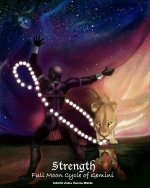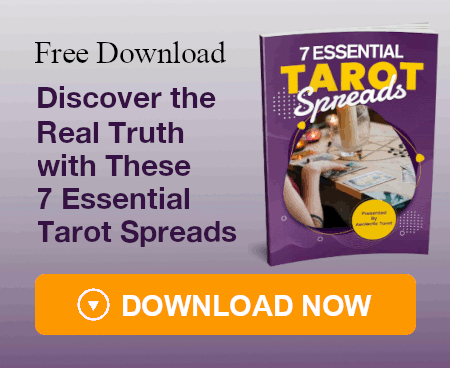greycats
The new lunar cycle proceeds under the eyes of the Gemini, the Twins, who like to manifest themselves at a line of division. This time it's the line marking the end of the Holly King's reign and the beginning of the Oak King’s, which is to say at the Winter Solstice. The Twins were present at the Summer solstice, too, but by day. This time they come by night. And nowhere does one see the night more beautifully interpreted than in the Maat tarot.
But Twins are not limited to the doorways of the year. According to ancient Egyptian mythology they also appear at dawn and dusk. In the Maat, we see the dark twin, a beautiful black man, drawing back the curtain of night. He seems to be standing with one foot in water and one on earth. The bright twin in the form of a lioness kneels down, perhaps to touch her brother's other form (the redder lion reflected in the water) so that he can take the sun from her mouth and place it up in the sky.
A long, lazy necklace of suns proceeds from her open mouth and loops around her brother creating an “8.” But the top loop of this "8" is much smaller than its bottom loop—which is the form of the analemma, the figure the sun traces upon the earth during the course of each year. Up above these Twins, the night sky has not yet disappeared. We see stars, bright and dim, singly and in drifts, some of which outline a woman’s form. She is Nut, the Egyptian goddess of the night sky and her face appears just above the dark twin’s left hand. Another “8,” one with equal loops, crowns her. We have twinned “8s.”
So what’s the deal with all these twins and how do they relate to strength?
In mythology are numerous divine or semi-divine twinsets, sometimes identical, more often not. They are frequently associated with animals and may take that form. They are almost always the offspring of an immortal father and a mortal mother. Perhaps for that reason they tend to be kind to human beings. The fraternal sets may be very unlike; in fact, dissimilarity seems to be the point. One twin could be animal, the other not; one could be mortal, the other not, one could be flesh and blood, the other a disembodied spirit. The only point at which these twins must match is this: between them they must account for the totality of whatever they represent—like day and night, heaven and earth, plants and animals. Body and soul. In the Maat’s “Strength” we also see a year and eternity, water and land, and “as above so below.”
That last phrase is important to pagans and means pretty much what it says: that everything in the cosmos will be mirrored on earth. For physical issues, that’s scarcely an article of faith. Rock dust on Mars is the same as rock dust on Earth. Our sun is one of many. The laws of physics seem to operate predictably on nearby objects at least, and one of these laws is that matter-energy is eternal. We were part of a star, once. We may be again. Yes, it’s material stuff. Easy. You can see it, touch it, do transformations on it. It’s the bright twin.
You can see it, touch it, do transformations on it. It’s the bright twin.
The dark twin, now—the beautiful one, so strong and so balanced. He may not be so easy. He may be transparent to our eyes and intangible on our skins. We may not be able to tell if he’s there. But he’s not unthinkable if we are strong enough.
“I think” is the key for this cycle (Maat, p. 53). And that's the Strength.
But Twins are not limited to the doorways of the year. According to ancient Egyptian mythology they also appear at dawn and dusk. In the Maat, we see the dark twin, a beautiful black man, drawing back the curtain of night. He seems to be standing with one foot in water and one on earth. The bright twin in the form of a lioness kneels down, perhaps to touch her brother's other form (the redder lion reflected in the water) so that he can take the sun from her mouth and place it up in the sky.
A long, lazy necklace of suns proceeds from her open mouth and loops around her brother creating an “8.” But the top loop of this "8" is much smaller than its bottom loop—which is the form of the analemma, the figure the sun traces upon the earth during the course of each year. Up above these Twins, the night sky has not yet disappeared. We see stars, bright and dim, singly and in drifts, some of which outline a woman’s form. She is Nut, the Egyptian goddess of the night sky and her face appears just above the dark twin’s left hand. Another “8,” one with equal loops, crowns her. We have twinned “8s.”
So what’s the deal with all these twins and how do they relate to strength?
In mythology are numerous divine or semi-divine twinsets, sometimes identical, more often not. They are frequently associated with animals and may take that form. They are almost always the offspring of an immortal father and a mortal mother. Perhaps for that reason they tend to be kind to human beings. The fraternal sets may be very unlike; in fact, dissimilarity seems to be the point. One twin could be animal, the other not; one could be mortal, the other not, one could be flesh and blood, the other a disembodied spirit. The only point at which these twins must match is this: between them they must account for the totality of whatever they represent—like day and night, heaven and earth, plants and animals. Body and soul. In the Maat’s “Strength” we also see a year and eternity, water and land, and “as above so below.”
That last phrase is important to pagans and means pretty much what it says: that everything in the cosmos will be mirrored on earth. For physical issues, that’s scarcely an article of faith. Rock dust on Mars is the same as rock dust on Earth. Our sun is one of many. The laws of physics seem to operate predictably on nearby objects at least, and one of these laws is that matter-energy is eternal. We were part of a star, once. We may be again. Yes, it’s material stuff. Easy.
The dark twin, now—the beautiful one, so strong and so balanced. He may not be so easy. He may be transparent to our eyes and intangible on our skins. We may not be able to tell if he’s there. But he’s not unthinkable if we are strong enough.
“I think” is the key for this cycle (Maat, p. 53). And that's the Strength.


